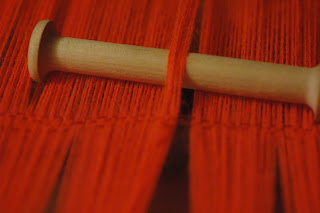 |
| Warping in sections can prevent tangling becoming epic. |
I used to make fun of my weaving teacher, Nancy. The studio had a huge stash of yarns to play with, and in the very back of the very top cabinet, there was a giant cone of orange wool. It was about three or four pounds of a very fine cobweb weight that broke if you looked at it funny. If you dusted the cone off enough, you could tell it was high-visibility orange. The don't-shoot-me orange that hunters wear.
No one in their right minds would ever use this. It was fine, delicate, and hideous. Why did she even have it?
So four years later I graduate, and I'm at the Maryladn Sheep and Wool Festival having the time of my life. Mom comes up to me with a big bag, grinning. "Guess what I got for $3!"
 |
| You mean they paid you $3, right? |
I think this wool was raided from a closing mill. It doesn't have a whole lot to recommend it to a handweaver. The hand is mediocre and it's terribly weak. I double it in the warp and will probably do the same in the weft.
On the plus side, and this is why I didn't make my mother return it, the yarn is wool. Most high-visibility clothing is made out of nasty synthetics that either don't insulate well, or insulate without breathing. It might be weak on the cone, but woven up it'll be a hard, sturdy fabric that can get dirty and be washed clean. Back in the day, wools like this were what endurance sports fabrics were made of.
 |
| I'll probably just cut out that mistake. |
Note: In the picture above you can see how I do my header. Put in three picks without beating, then beat back suddenly. Not only is it as effective as the traditional toilet paper or scrap rags, on fine yarns it'll even out tension. It's really cool how you slam the beater back and then up pop all the loose threads.
No comments:
Post a Comment